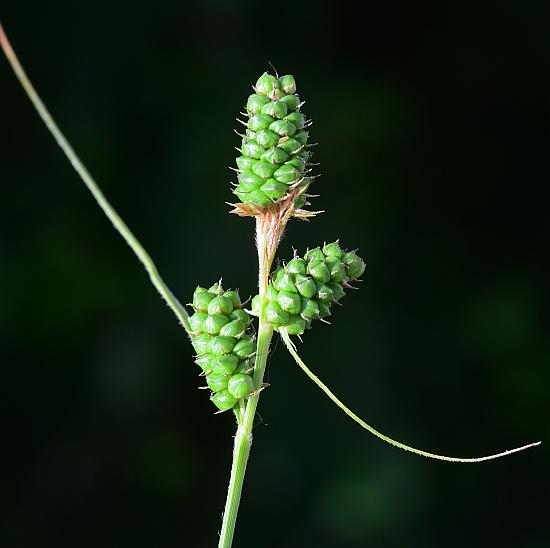Carex bushii Mack.
Bush's Sedge

Native
CC = 4
CW = 3
MOC = 71
© SRTurner
Carex bushii Mack.Bush's Sedge | |
 |
Native CC = 4 CW = 3 MOC = 71 |
© SRTurner |
|
Family - Cyperaceae Habit - Monoecious sedge, with rhizomes absent or poorly developed, forming dense clumps. Short vegetative stems also produced. Stems - Flowering stems to 90 cm, erect or nearly so, sparsely hairy, more or less reddish tinged at the base. Leaves - Leaves shorter than to longer than the stems. Leaf blades 2-30 cm long, 1.5-4.0 mm wide, hairy on both surfaces or sometimes sparsely hairy to nearly glabrous except at the base, flat, green. Leaf sheaths densely hairy, green, often somewhat reddish tinged at the tip, the ligule about as long as wide and U-shaped.
Inflorescences - Terminal spike 12-22 mm long, 4.5-11.0 mm wide. Lateral spikes usually densely clustered near the tip of the axis, 5-16 mm long, 4.5-11.0 mm wide, sessile or nearly so, erect to ascending, with 15-40 dense perigynia.
Perigynia - Staminate scales 3.2-5.2 mm long, lanceolate, tapered to a usually awned tip, light brown with a green midrib and lighter margins, often somewhat reddish tinged. Pistillate scales 3-6 mm long, longer than the perigynia, lanceolate, the tip tapered to a spreading awn 0.5-2.0 mm long, reddish brown with a green midrib and lighter margins, usually sparsely hairy. Perigynia 2.4-3.5 mm long, spreading, obovate in outline, bluntly trigonous to nearly circular in cross-section and somewhat inflated, narrowed to a beakless tip, narrowed to a thick, short, stalklike base, the surface with 9-13 strong nerves, minutely pebbled, olive green. Fruits 2.0-2.6 mm long, obovate in outline, the very short beak bent to the side.
Flowering - May - July. Habitat - Prairies, forest openings, pond margins, ditches, railroads, roadsides, fields, pastures, disturbed open ground. Origin - Native to the U.S. Lookalikes - C. hirsutella. Other info. - This sedge is common throughout most of Missouri, except for the northwestern corner. Its main range falls within a band extending from Illinois and Missouri down through parts of eastern Texas, with more scattered populations found into New England. This species is visually characterized by small, conical spikes at the stem tip. Typically there are three of these, with the terminal one bearing a conspicuous staminate region beneath the perigynia (see image above). The stems and leaves are slender, and the leaf sheaths (and usually the leaf blades) are densely hairy. In Carex bushii, the pistillate scales are longer than the perigynia, protruding outward and giving the spike a bristly appearance. This serves to differentiate the species from C. hirsutella, which has pistillate scales shorter than the perigynia. Photographs taken at Weldon Spring Conservation Area, St. Charles County, MO, 6-2-2020 (SRTurner). |